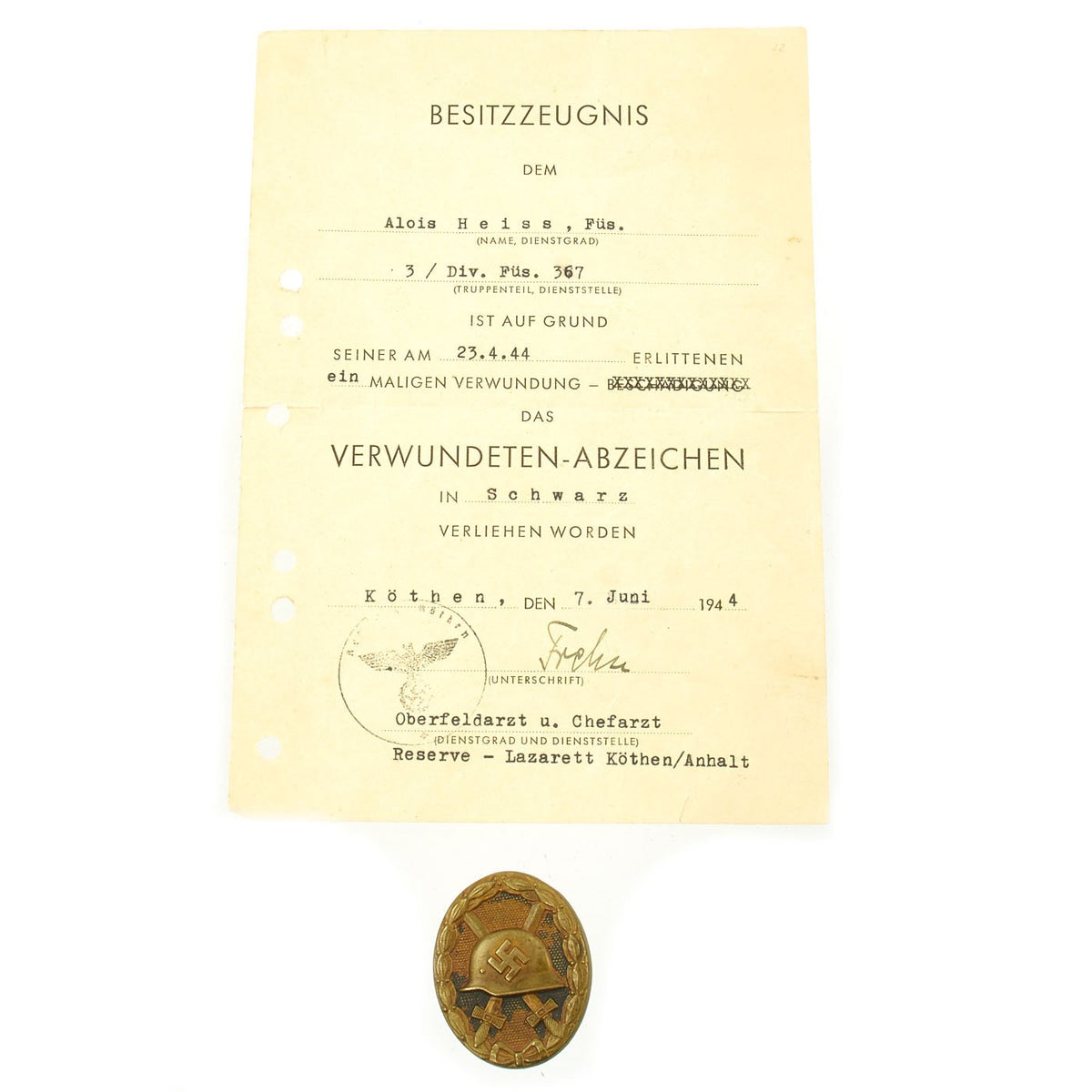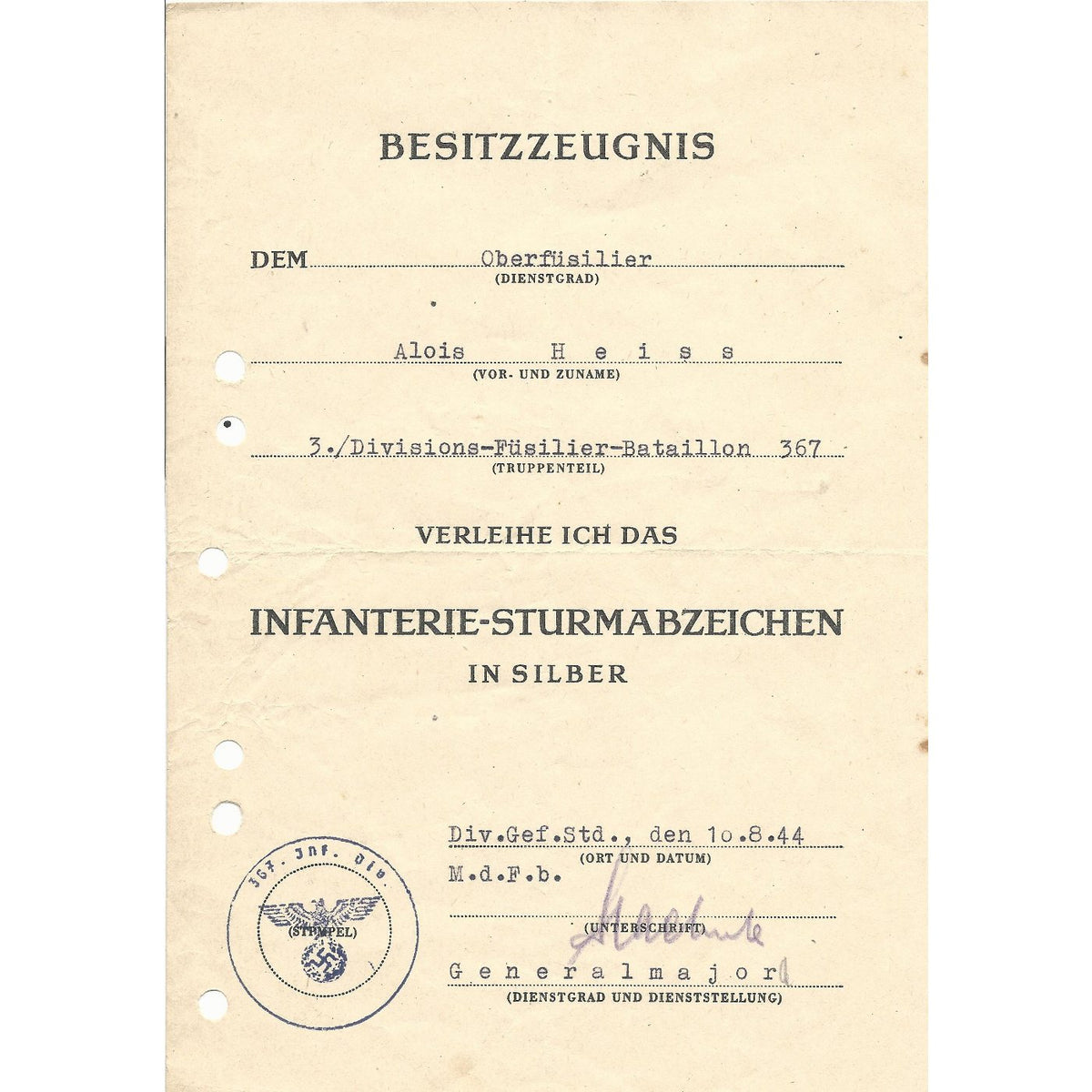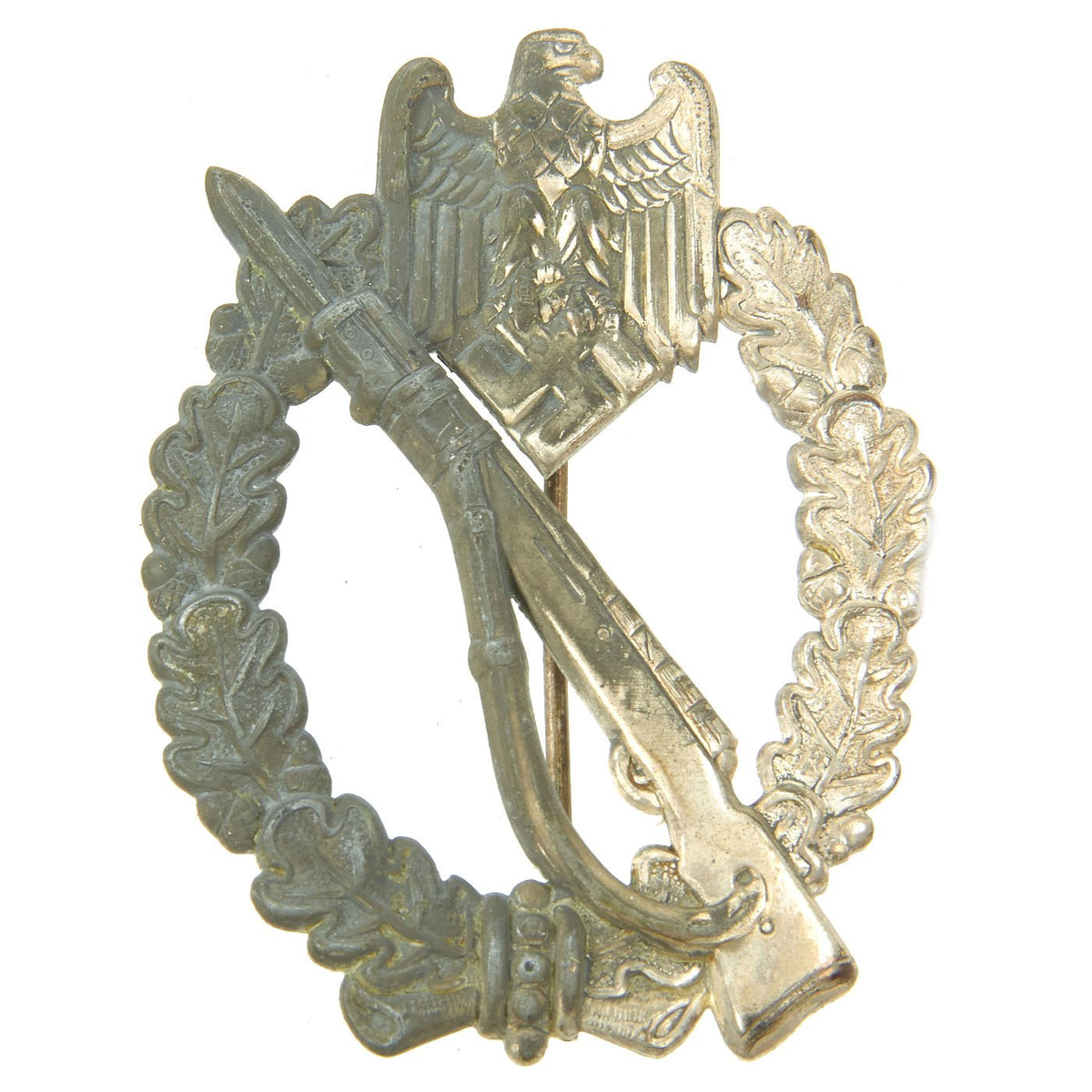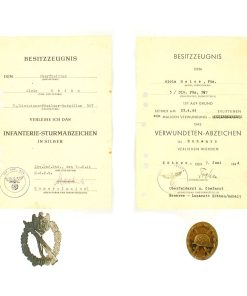Original German WWII Black Wound Badge & Silver Infantry Assault Badge with Named Award Documents – Dated 1944 Original Items
$ 395,00 $ 118,50
Original Items: One-of-a-kind grouping. This is a fantastic set, with two original German WWII combat awards, each with their original BESITTZZEUGNIS “possession/award” certificates. Both were awarded to the same soldier, Füsilier and later Oberfüsilier Alois Heiss. Both are dated in 1944, making this a great set showing the progression of a “Private” level soldier, who was promoted to “Senior Private”. He was a member of the 3./Divisions-Füsilier-Battalon 367, as indicated on both documents.
The two awards earned by this soldier are the Verwundetenabzeichen (Wound Badge) 3rd Class in Schwarz (Black), and the Infanterie-Sturmabzeichen (Infantry Assault Badge) in Silber (Silver). Both awards are the later “hollow back” stamped variety, and retain a some of their original finish. As with most badges, the rear retains the finish better than the front. Both are unmarked, typical of late war production.
The two award documents measure approximately, 8″ x 5.5″, (20cm x 14cm), and are printed on mid-weight paper with black print and typed in particulars. The earlier document indicates that that, Füsilier Alois Heiss was awarded the Wound Badge in Black for injuries received the 23rd of April 1944. The document bears the authorizing signature of an Oberfeldarzt (Senior Field Surgeon) and was presented on 7. Juni 1944.. It bears the correct inspection stamp. The later document indicates that the now Oberfüsilier Alois Heiss was awarded the Infantry Assault Badge in Silver on 10.8.44, and has the signature of a Generalmajor (Major General) on the bottom, as well as the correct inspection stamp.
Both documents are in very good condition, with the expected wear and yellowing from age. These were originally folded in half, so one of the documents has started to tear at the fold line, as shown.
A really nice German WWII set of two awards, complete with the original documents named to the same soldier. Ready to display!
The Wound Badge (German: Verwundetenabzeichen) was a military decoration first promulgated by Wilhelm II, German Emperor on 3 March 1918, which was awarded to wounded or frostbitten soldiers of the Imperial German Army, during World War I. Between the world wars, it was awarded to members of the German armed forces who fought on the Nationalist side of the Spanish Civil War, 1938–39, and received combat related wounds. It was awarded to members in the Reichswehr, the Wehrmacht, SS and the auxiliary service organizations during the Second World War. After March 1943, due to the increasing number of Allied bombings, it was also awarded to wounded civilians in air raids. It was awarded when the wound was the result of enemy hostile action, with an exception being for frostbite.
The badge had three classes:
– Black (3rd class, representing Iron), for those wounded once or twice by hostile action (including air raids).
– Silver (2nd class) for being wounded three or four times.
– Gold (1st class, which could be awarded posthumously) for five or more times wounded.
The “progression” could be waived in the event of loss of a limb or eyesight; when such a severe wound occurred, the silver badge was awarded.
Badges were made of pressed steel, brass and zinc. All versions of the Wound Badge were worn on the lower left breast of the uniform or tunic. The badge was worn below all other awards on the left. It ranked lower than combat badges. There were 24 approved manufacturers of the Wound Badge. At first, the Wound Badge in Black was stamped from sheet brass, painted semi-matte black with a hollow reverse pin back attachment or of solid construction. From 1942, steel was used to make the badges. The Wound Badge in silver was made (before 1942) from silver-plated brass, and (after 1942) from lacquered zinc, and had a solid reverse with either a needle pin or a broad flat pin bar. The Wound Badge in Gold was a gilded version of the Wound Badge in Silver.
The Infantry Assault Badge (German: Infanterie-Sturmabzeichen) was a German war badge awarded to Waffen-SS and Wehrmacht Heer soldiers during the Second World War. This decoration was instituted on 20 December 1939 by the Commander-in-Chief of the German Army, Generalfeldmarschall Walther von Brauchitsch. It could be awarded to members of non-motorized Infantry units and units of the Gebirgsjäger that had participated in infantry assaults, with light infantry weapons, on at least three separate days of battle in the front line on or after 1 January 1940. When a counter offensive led to fighting, it could also apply. Award of the Infantry Assault Badge was authorized at regimental command level.
Fast Shipping with Professional Packaging
Thanks to our longstanding association with UPS FedEx DHL, and other major international carriers, we are able to provide a range of shipping options. Our warehouse staff is expertly trained and will wrap your products according to our exact and precise specifications. Prior to shipping, your goods will be thoroughly examined and securely secured. We ship to thousands clients each day across multiple countries. This shows how we're dedicated to be the largest retailer on the internet. Warehouses and distribution centres can be located throughout Europe as well as the USA.
Note: Orders with more than one item will be assigned a processing date depending on the item.
Before shipping before shipping, we'll conduct a thorough inspection of the items you have ordered. Today, the majority of orders will be delivered within 48 hours. The delivery time will be between 3-7 days.
Returns
The stock is dynamic and we cannot completely manage it because multiple stakeholders are involved, including our factory and warehouse. So the actual stock may alter at any time. It's possible that you may not receive your order once the order has been made.
Our policy is valid for a period of 30 days. If you don't receive the product within 30 days, we are not able to issue a refund or an exchange.
You can only return an item if it is unused and in the same state as the day you received it. You must have the item in its original packaging.
Related products
Uncategorized
Uncategorized
Australian WWII Owen MK1 Machine Carbine SMG Custom Fabricated Replica with Sling Original Items
Uncategorized
Uncategorized
Uncategorized
Uncategorized
Uncategorized
Uncategorized
Uncategorized
Uncategorized
Uncategorized
Uncategorized
Uncategorized
Angolan Rebel 1970s era 60mm Inert Display Mortar from Angolan Civil War Original Items
Uncategorized
Uncategorized
Uncategorized
Armoured Fighting Vehicles of the World: AFVs of World War One (Hardcover Book) New Made Items
Uncategorized












































































